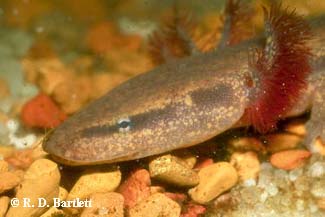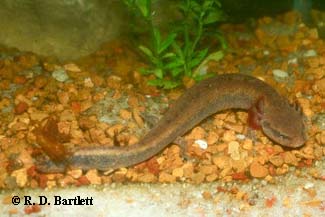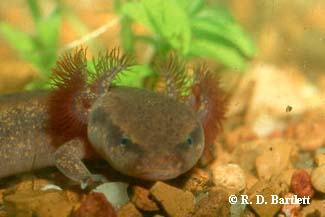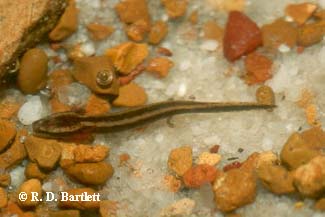| Necturus alabamensis | |||||||||||||
| Black Warrior Waterdog | |||||||||||||

|
|
||||||||||||
| N. alabamensis, Black Warrior River, AL |
Taxonomy
This species is under much taxonomic dispute. There are two separate populations of the "Alabama Waterdog," one to the north of the fault line in Alabama in the Black Warrior River drainage, and another in southern Alabama and the Florida panhandle. At this point it seems likely that the northern population will retain the name N. alabamensis and the southern population is currently undescribed (Bartlett and Bartlett 2006). Their ranges may overlap in some areas. In this account I will be referencing the northern population restricted to the Black Warrior River drainage; the other is covered separately: Necturus sp. cf. beyeri.
Description
In most respects, this waterdog is most similar to N. maculosus, as it is rather flattened and spotted. The underside is light without spots or blotches. Its ground color is light to dark brown. Like all Necturus, this species has four toes on all feet and bright red external gills. The larvae are very similar to N. maculosus larvae and are dark with yellow stripes. The adults reach lengths of up to 25 cm (10 in).
Range
Only found in the Black Warrior River drainage of northern Alabama.
Habitat
This waterdog is found in medium to large streams with plenty of cover. Larvae and juveniles can be found in debris, such as leaves and other forms of detritus. Adults use rocks and logs as cover and may prefer streams with a lot of debris.
Comments
This species is endangered and has a very restricted range.
 N. alabamensis, Black Warrior River, AL. |
 N. alabamensis, Black Warrior River, AL. |
 N. alabamensis larva. Black Warrior River, AL. |
References
Bartlett, R.D. and P. Bartlett 2006. Guide and Reference to the Amphibians of Eastern and Central North America (North of Mexico). University Press of Florida: Gainesville, Florida.
Bishop, S. C. 1943. Handbook of Salamanders. Comstock Publishing Company: Ithaca, NY.
Collins, J. T. Black Warrior Waterdog. The Center for North American Herpetology [online]. Accessed October 15, 2009. http://www.cnah.org/detail.asp?id=939
Petranka, J. W. 1998. Salamanders of the United States and Canada. Smithsonian Institute Press: Washington DC.
Text © 2009 Ryan St. Laurent
